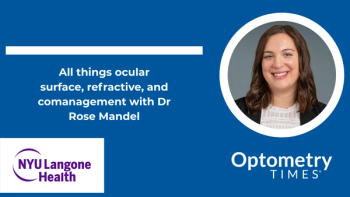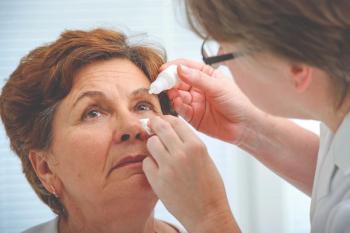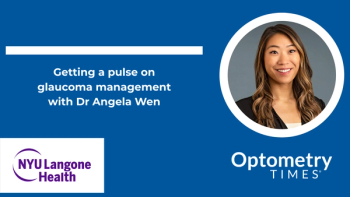
Top 10 questions about cross-linking
Keratoconus treatment has changed much over the past several years. Avedro’s U.S. Food and Drug Administration (FDA) approval of corneal cross-linking has given more patients hope for better vision.
Keratoconus treatment has changed much over the past several years. Avedro’s U.S. Food and Drug Administration (FDA) approval of corneal cross-linking has given more patients hope for better vision.
In the past, we could only watch and wait, hoping that keratoconus patients would not progress enough to have significantly reduced vision or require a corneal transplant. Cross-linking has given our patients the opportunity to get on with their lives without fear of reduced quality of life from ectatic disease.
The practice where I work was a clinical trial site for cross-linking, and now our offices perform cross-linking for progressive keratoconus and ectasia on a near-daily basis. I have been fortunate to see a wide range of patients undergo this procedure and to be able to participate in their pre- and postop care.
Related:
But with a new paradigm comes new responsibilities for screening, diagnosis, and care. Here are answers to 10 common questions about cross-linking.
1. What are the results of cross-linking?
Cross-linking has been accepted as the standard of care in many countries outside the United States for some time as a safe and effective treatment to stabilize the disease. The international literature suggests that progression of keratoconus is halted in nearly all patients (92 percent to 100 percent) who undergo the procedure,1 and that stabilization of the cornea is maintained over the long term, for at least 10 years after treatment.2
In the United States, three prospective, randomized, controlled trials were conducted, enrolling a total of 335 patients. Among the subjects with progressive keratoconus, maximum keratometry values (Kmax) improved by 1.60 D ± 4.20 D from baseline to one year in the treated group and worsened by 1.00 D ± 5.10 D in the control group. Eyes treated with cross-linking had a mean gain of 5.5 ETDRS letters, with 24 percent gaining two or more lines of corrected distance visual acuity (CDVA).3
2. What is approved in the United States?
The U.S. clinical trials led to approval of cross-linking for the treatment of progressive keratoconus or corneal ectasia following refractive surgery using the Avedro KXL System with photoenhancing solutions Photrexa or Photrexa Viscous. No other cross-linking system is approved for use in the United States, and other systems may be used only as part of a formal investigational new drug (IND) study being conducted in coordination with the FDA.
Related:
3. Who should have cross-linking?
All patients with keratoconus should be evaluated to determine whether progression is occurring and whether cross-linking is indicated. As we know, keratoconus often progresses rapidly during puberty and the young adult years. Cross-linking is intended to prevent further progression but may not restore vision that has already been lost. Therefore, it is our responsibility to identify these patients early and educate them regarding the opportunity for cross-linking treatment.
Delaying treatment may result in a greater chance of corneal thinning, scarring, hydrops, and corneal transplant. Progression often slows or stops in patients over age 35 or 40; however, we have seen patients who continue to progress through their 40s and 50s, and therefore it is certainly worth monitoring these patients for progression.
While the corneal stroma must be at least 400 µm thick to proceed with cross-linking, Photrexa is available to thicken the corneal stroma to enable cross-linking in many cases.
4. What is the best way to identify early-stage keratoconus?
By the time patients have striae or scarring that is visible at the slit lamp, their disease is already advanced, so it would be ideal to catch them before that happens. Topography is the best way to identify early ectatic changes in the cornea. For optometrists who don’t have a topographer on-site, it is worthwhile to establish a relationship with an area provider who will accept referrals for topographic exams.
I encourage a careful look at any patient who has had an increase in his cylinder correction or fluctuating vision over a short period of time, especially if he cannot be corrected to better than 20/30. Subjective complaints of blurry, shadowy vision, or vision that just isn’t crisp, along with frequent cylinder changes, eye rubbing, or a family history of keratoconus, should also trigger an extra level of concern.
Related:
5. Can I comanage my patients if I refer them for cross-linking?
Yes. Cross-linking is well-suited for comanagement because the optometrist’s contact lens knowledge is an important part of the postoperative care.
In our office, we typically see comanaged patients for the one-day postop visit, then send them back to the referring clinician for the one-week visit and beyond. Practices that want to comanage corneal cross-linking should consider investing in a good topographer in order to be able to monitor the corneal curvature postoperatively (Figure 1).
6. What happens during the procedure?
First, the epithelium will be debrided for an epi-off procedure. Photoenhancing riboflavin drops (Photrexa Viscous) will be applied to the cornea. It takes about 30 minutes for the riboflavin to penetrate the corneal stroma.
After the stroma is soaked in riboflavin, the ophthalmologist will check the anterior chamber and measure the cornea to be sure it is at least 400 µm thick. If the cornea is too thin, Photrexa drops are used to thicken the cornea to 400 µm.
Related:
Next, ultraviolet (UV) light will be applied for about 30 minutes with the KXL system, along with more riboflavin drops (Figure 2).
At the conclusion of this process, a bandage contact lens (BCL) is placed on the eye. The postoperative topical regimen includes a nonsteroidal anti-inflammatory for a few days, antibiotic drops for a week (or as long as the BCL remains in place), and corticosteroid drops for up to a month.
7. Epi on or epi off?
The epi-off procedure is the procedure that was evaluated in the clinical trials and is considered on-label in the United States. The advantage of the epi-off or “Dresden protocol” method is that the riboflavin penetrates the cornea thoroughly and relatively quickly.
Some people advocate epi-on cross-linking, in which the epithelium is left intact (also called transepithelial cross-linking) because not having an epithelial defect eliminates the need for a BCL and antibiotics.
Epi-on could make the healing process faster and more comfortable for patients. However, the safety and efficacy of epi-on procedures have not been evaluated by the FDA. Additionally, epi-on procedures often require different riboflavin drug formulations that are not approved in the United States. Published results of the epi-on approach have been mixed, with some studies suggesting that it is not as efficacious as epi-off.
8. Does insurance typically cover the procedure?
Insurance coverage and coding requirements are still evolving. Some major carriers, such as Aetna, have already begun covering the procedure, while others may require the patient to pay for the procedure out-of-pocket as an uncovered service.
To help patients afford access to care, Avedro has recently made a patient assistance program available. The company provides the photoenhancing riboflavin solutions at no charge to low-income, uninsured patients and minimizes the out-of-pocket expenses for the riboflavin solutions in cases of insurance denials. The company also offers a reimbursement support service that includes resources to assist with the commercial payer appeals process.
9. What should I expect to see postop?
During the first week after the procedure, we are primarily watching for the gradual return of corneal clarity and checking for the presence of infiltrates or any sign of infection. The epithelium should be healing well, and the bandage contact lens can typically be removed at one week.
Related:
It is perfectly normal to still see some stromal haze at one week, gradually resolving over about one month. In my experience, patients have very little discomfort or irritation.
Once the cornea is clear and the epithelium has closed, patients can return to contact lens wear. In some cases, contact lenses may need to be refit due to changes in corneal curvature.
10. Does cross-linking change visual acuity?
Changes in vision may take place throughout the early postoperative period and even for a year or longer. I like to wait about three months before refitting patients with a new contact lens prescription, but it is important to let patients know that they may require more frequent refits than usual in the first year or two after the procedure.
The primary goal of cross-linking is to stabilize the cornea and prevent vision from worsening, but we often see reductions in astigmatic error and improvements in visual acuity because the cross-linking procedure also slightly flattens the cornea.
Related:
Exciting changes
I have found it tremendously satisfying to see a teenager or young adult have a cross-linking procedure and know that I am helping to protect this patient from further progression. This has been a huge paradigm shift for all of us in eye care. We can be proactive about stopping this disease, offering hope to patients. I think it’s exciting to be a part of this change.
References
1. Koller T, Mrochen M, Seiler T. Complication and failure rates after corneal crosslinking. J Cataract Refract Surg. 2009 Aug;35(8):1358-62.
2. Raiskup F, Theuring A, Pillunat LE, Spoerl E. Corneal collagen crosslinking with riboflavin and ultraviolet-A light in progressive keratoconus: ten-year results. J Cataract Refract Surg. 2015 Jan;41(1):41-6.
3. Hersh PS, Stulting RD, Muller D, Durrie DS, Rajpal RK; U.S. Crosslinking Study Group. United States multicenter clinical trial of corneal collagen crosslinking for keratoconus treatment. Ophthalmology. 2017 Sep;124(9):1259-1270.
Newsletter
Want more insights like this? Subscribe to Optometry Times and get clinical pearls and practice tips delivered straight to your inbox.




















































.png)


